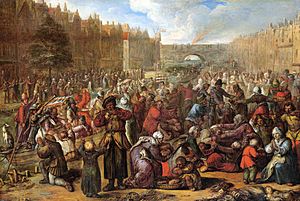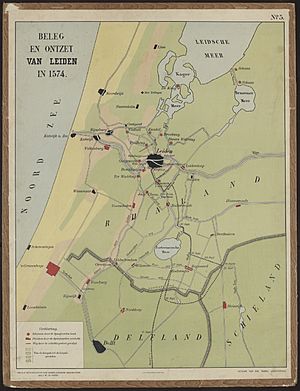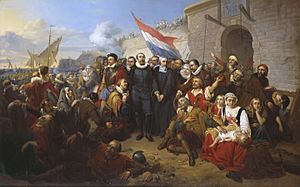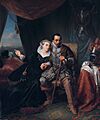Siege of Leiden facts for kids
Quick facts for kids Siege of Leiden |
|||||||
|---|---|---|---|---|---|---|---|
| Part of the Eighty Years' War & the Anglo–Spanish War | |||||||
 Relief of Leiden by the Geuzen on flat-bottomed boats, on 3 October 1574. Otto van Veen. |
|||||||
|
|||||||
| Belligerents | |||||||
|
|||||||
| Commanders and leaders | |||||||
| Pieter Adriaanszoon van der Werff (Mayor of Leiden) | Francisco de Valdez | ||||||
| Strength | |||||||
| 11,000 | 15,000 | ||||||
| Casualties and losses | |||||||
| 500 | 2,000 | ||||||
The Siege of Leiden was an important event during the Eighty Years' War and the Anglo–Spanish War. It happened in 1573 and 1574. Spanish forces, led by Francisco de Valdez, tried to capture the city of Leiden in the Netherlands. However, the city was successfully saved in October 1574, leading to a Dutch victory.
Contents
Why the Siege Happened
The Eighty Years' War was a long fight where Dutch rebels fought against the King of Spain. The King's family had taken control of the Seventeen Provinces of the Netherlands. By 1572, many areas like Holland and Zeeland were taken by rebels. They wanted to end the harsh rule of the Spanish governor, the Duke of Alba.
Spanish Tactics and Rebel Resistance
The Duke of Alba used brutal methods to crush the rebellion. He used Amsterdam as his main base because it was loyal to Spain. Alba's cruel actions after sieges, like in Naarden and Haarlem, were well known. This made the rebels determined to fight as long as possible. After a seven-month siege, Haarlem was captured by the Spanish. This split the county of Holland in two.
Alba then tried to take Alkmaar in the north, but the city held strong. He then sent his officer, Francisco de Valdez, to attack the rebel areas in the south, starting with Leiden. Because Alba had not stopped the rebellion quickly, he resigned. King Philip accepted his resignation in December. A new, less harsh governor, Luis de Zúñiga y Requesens, took his place.
First Siege of Leiden
The city of Leiden had stored a lot of food before the siege began in October 1573. The Spanish found it very hard to attack. The ground was too soft to dig trenches, and the city's defenses were strong. The defenders of Leiden included Dutch rebels, English, Scottish, and French Huguenot soldiers.
Attempt to Relieve the City
The leader of the Dutch rebels, William the Silent, also known as the Prince of Orange, tried to help Leiden. He sent an army into the Netherlands led by his brother, Louis of Nassau. Valdez stopped the siege in April 1574 to face these invading rebel troops. However, Sancho d'Avila reached them first. He defeated them in the Battle of Mookerheyde, where Louis was killed.
Second Siege and Relief of Leiden

During a short break from the siege, the Prince of Orange advised the people of Leiden to get more supplies and bring in more soldiers. But they did not follow his advice. So, when Valdez's army returned on May 26, 1574, the city was in a bad state again. The people thought about giving up because supplies were low and there was little hope of help. The defeat of Louis's army also lowered their spirits.
The Prince's Plan to Flood the Land
However, the Prince of Orange was determined to save the city. He sent a carrier pigeon into Leiden, asking them to hold out for three months. To keep this promise, he planned to break the dykes (walls that hold back water) to let the sea flood the low-lying land. This would allow the rebel fleet to reach the city and force the Spanish to leave. This tactic had also worked to save Alkmaar.
Flooding the countryside would cause huge damage. Because of this, the local people did not want the dykes to be broken. But the Prince convinced them, and the outer dykes were broken on August 3. Before this, the Prince's Admiral, Louis Boisot, had gathered over 200 small, flat-bottomed boats. These boats were manned by 2,500 experienced Dutch sailors and carried a lot of food for the starving people of Leiden.
Soon after the first dykes were broken, the Prince of Orange became very ill. This stopped the rescue efforts. Also, the flooding took longer than expected because of bad winds. On August 21, the people of Leiden sent a message to the Prince. They said they had held out for three months, two with food and one without. The Prince replied by pigeon, assuring them that all dykes were broken and help would come soon.
The Fleet's Difficult Journey
The rescue mission continued seriously on September 1, after the Prince recovered. More than 15 miles separated the rebel fleet from Leiden. Ten miles were covered easily. On the night of September 10, the fleet reached the Landscheiding, a barrier blocking their way. They captured it in a surprise night attack. The Spanish had not protected this important spot well. The next morning, the Spanish tried to take it back but were pushed away, losing many men. The dyke was broken, and the fleet moved closer to Leiden.
Admiral Boisot and the Prince of Orange had been given wrong information about the land. They thought breaking the Landscheiding would flood the whole area to Leiden. Instead, the fleet found its path blocked again by the Greenway dike. This dike was less than a mile from the Landscheiding and was still a foot above the water. Again, the Spanish had left this dike mostly unprotected, and the Dutch broke through it easily.
However, easterly winds pushed the water back towards the sea. The water also spread over a larger area, making it so shallow that the fleet almost got stuck. The only deep path was a canal leading to a large lake called the Zoetermeer (freshwater lake). This canal and its bridge were strongly defended by the Spanish. After a short fight, the Admiral gave up. He sent a sad message to the Prince, saying they were lost unless the wind changed.
Leiden's Determination to Survive
Meanwhile, inside the city, people demanded to surrender when they saw their countrymen stuck. But Mayor Pieter Adriaanszoon van der Werff inspired his citizens to keep fighting. He told them they would have to kill him before the city could surrender. He even said they could eat his arm if they were truly desperate. Sadly, thousands of people died from starvation. To make things worse, the plague spread through the city, killing nearly eight thousand more. The city only held out because they knew the Spanish soldiers would kill everyone if they surrendered, just like what happened in Naarden and other cities. Admiral Boisot sent another pigeon, promising quick help.
The Final Push
On October 18, the wind changed again. It blew strongly from the west, pushing the sea against the dams. With the water rising, the fleet could soon go around the bridge and canal and successfully enter the Zoetermeer. In October, the Dutch patriots, led by William the Silent, destroyed the dykes in four more places. This created an obstacle the Spanish troops could not cross. Because of this and the strong west wind, the water rose, and Spanish troops could not move. A monument called the Groenedijk Monument now stands at one of these locations.
The Sea Beggars, led by Admiral Louis de Boisot, used their ships to their advantage. Several fortified villages now stood in the way of the patriot fleet. The Dutch Admiral was still worried about losing, but the Spanish panicked because of the rising water. They offered little resistance. All their strongholds, which had become islands, were left empty by the Royalist troops as they fled. Only the village of Lammen remained. This was a small fort commanded by Colonel Borgia, about three-quarters of a mile from Leiden's walls.
Lammen was a tough obstacle. But the Spanish, who were good at land fighting but not water warfare, gave up. They couldn't fight against the sea and the experienced Dutch sailors. So, the Spanish commander Valdez ordered a retreat on the night of October 2. The army fled, even more scared by a loud crash they heard from the city. They thought the people of Leiden were breaking another dam. Actually, part of Leiden's wall, weakened by the seawater, had fallen, leaving the city completely open if anyone had stayed to attack.
The next day, the rescue forces arrived at the city. They fed the hungry citizens with herring and white bread. That evening, people also enjoyed hutspot (a stew of carrots and onions). A famous story says that a young orphan boy named Cornelis Joppenszoon found a cooking pot full of hutspot. The Spanish had left it behind when they quickly left their camp at Lammenschans to escape the rising waters.
What Happened Next
In 1575, the Spanish government ran out of money. This meant the Spanish army could not be paid, and the soldiers rebelled. After the city of Antwerp was looted, the whole of the Netherlands rebelled against Spain. Leiden was safe once again.
William of Orange founded Leiden University to honor the city's bravery during the siege. Even though the Prince was fighting against King Philip of Spain, he pretended to act on the King's behalf. So, the university was officially started in the King's name.
Every year, Leiden celebrates the 3 October Festival. It's a big party with a funfair and many outdoor discos at night. The city gives free herring and white bread to its citizens, just like the day the city was saved.
Images for kids
-
The "legend", confirmed by historical research in 2014, of Magdalena Moons and Francisco de Valdez became a popular story after the siege of 1574: painting by Simon Opzoomer, c. 1845.
See also
 In Spanish: Asedio de Leiden para niños
In Spanish: Asedio de Leiden para niños




